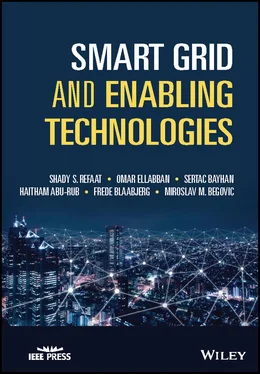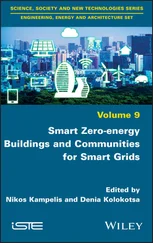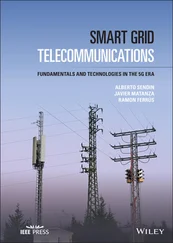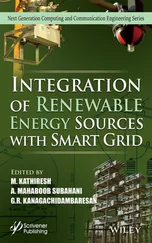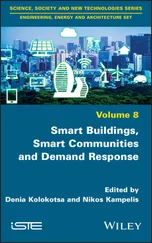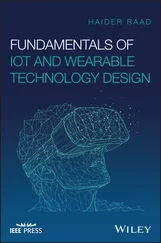Frede Blaabjerg - Smart Grid and Enabling Technologies
Здесь есть возможность читать онлайн «Frede Blaabjerg - Smart Grid and Enabling Technologies» — ознакомительный отрывок электронной книги совершенно бесплатно, а после прочтения отрывка купить полную версию. В некоторых случаях можно слушать аудио, скачать через торрент в формате fb2 и присутствует краткое содержание. Жанр: unrecognised, на английском языке. Описание произведения, (предисловие) а так же отзывы посетителей доступны на портале библиотеки ЛибКат.
- Название:Smart Grid and Enabling Technologies
- Автор:
- Жанр:
- Год:неизвестен
- ISBN:нет данных
- Рейтинг книги:3 / 5. Голосов: 1
-
Избранное:Добавить в избранное
- Отзывы:
-
Ваша оценка:
- 60
- 1
- 2
- 3
- 4
- 5
Smart Grid and Enabling Technologies: краткое содержание, описание и аннотация
Предлагаем к чтению аннотацию, описание, краткое содержание или предисловие (зависит от того, что написал сам автор книги «Smart Grid and Enabling Technologies»). Если вы не нашли необходимую информацию о книге — напишите в комментариях, мы постараемся отыскать её.
Smart Grid and Enabling Technologies
Smart Grid and Enabling Technologies
Smart Grid and Enabling Technologies — читать онлайн ознакомительный отрывок
Ниже представлен текст книги, разбитый по страницам. Система сохранения места последней прочитанной страницы, позволяет с удобством читать онлайн бесплатно книгу «Smart Grid and Enabling Technologies», без необходимости каждый раз заново искать на чём Вы остановились. Поставьте закладку, и сможете в любой момент перейти на страницу, на которой закончили чтение.
Интервал:
Закладка:
The SG will be flexible to the customers' active participation. Consumers will utilize the grid in a number ways, more consumers will be “prosumers”: both producers and consumers of energy and to additionally store the energy. The grid will no longer be merely a “delivery pipe” for electric power. All connected to the grid will be masters, no slave and master roles for them in future SGs [42]. The grid can constantly deliver power against disturbances (in extreme climate conditions and periods of natural disasters) without outages over a large area and could maintain information security against various attacks [43].
1.7.2 Improved Efficiency
Energy efficiency and product innovation programs are coupled together to make industrial and consumer sectors more efficient than they have been for a long time [44]. A SG with distributed energy generation allows for lower transmission and distribution losses which make the whole system more efficient. All parties connected to the grid work smartly for programs that improve the efficient use and delivery of electricity.
1.7.3 Smart Transportation
Electric transportation has been evolving rapidly during the past few years. The installation of smart EVs in the energy market can compensate for the need of major grid's infrastructure expansion. This compensation can be achieved if the EVs battery technologies allow for vehicle to grid (V2G), grid to vehicle (G2V) and vehicle to building (V2B) power flows to perform large‐scale mobile storage and are combined with suitable pricing schemes to support the grid performance and economy. EV technology might be one of the most significant accelerators of SG adoption. Also, battery cost, size, and weight declination are considered as some of most important research topics related to EV deployment [45].
1.7.4 Demand Response Support
SG permits generators and loads to interrelate in an automated way in real‐time, which allows customers to play a major role in optimizing the operation of the whole grid. Also, giving the consumers timely information enables them to reduce their energy bills by modifying their consumption patterns to overcome some of the constraints in the power system. DR and DSM are essential programs in SGs. DSM is applied for long‐term planning such as for shifting the load peak over time. DR ensures short‐term load response to improve the energy consumption profile over time. This could be realized by creating a dynamic electricity price. Consumers have the choice and authority over their consumption patterns. Various financial incentives could be created to adjust the level of demand and generation at strategic periods of the day. Figure 1.16presents a classification of DR programs. Implementing DR programs into the operational aspects of the system has different benefits such as reducing the peak load and avoiding the need for new power plants and infrastructure oversizing [46].
DR programs are categorized into two main programs, time‐based programs, and incentive‐based programs. In the time‐based DR programs, the change in electricity prices can vary automatically at different times based on customer electricity consumption as per the contracts signed with the operator. While, with the incentive‐based DR programs, the customer is offered some incentives to participate in a fixed or varying period. The benefits will increase by triggering an incentive price to affect customer behavior by decreasing demand consumption.

Figure 1.16 Classification of DR.
Currently, DR is only used by large commercial consumers, and its operation is based on informal signals such as phone calls by the utility or by the DR provider asking the consumer to lower their energy consumption during peak times for energy demand [47]. There are four main obstacles in the face of the uptake of DR:
1 The shortfall of market integration.
2 Improving incentive‐based DR programs.
3 The need for increased adoption of enabling technologies.
4 More communication in the power grid which is associated with privacy and security concerns.
1.7.5 Reliability and Power Quality
The SG utilizes technologies such as improved fault detection, state estimation, and enabling self‐healing of the network without the need for specialized personnel. This leads to a reliable supply of electricity and minimized vulnerability to attacks or natural disasters. Smart grid operates resiliently in disasters and during physical, or cyber‐attacks. Advanced control methods and monitoring oversee essential elements of the grid, enable rapid diagnosis and solutions to events that affect the grid's integrity, power quality, and smooth operation. The grid can monitor both on‐line and in real‐time as well as assess its current state and predict its future situation. The SG has robust risk warning procedures to employ preventive capabilities, automatic fault diagnosis, self‐fault isolation, and self‐restoration [48]. With all‐new energy resources and entities, optimization and handling the system will become more challenging, even with the availability of new technologies and tools. Interdependencies and interactions between distribution and transmission systems will keep rising. The increase in the grid's complexity will require many technological, computational, and business operation requirements such as [49, 50]:
1 Self‐learning systems.
2 Increased coordination between transmission‐level balancing areas as well as additional balancing abilities at the distribution level.
3 Balancing abilities using both load‐side and supply‐side operations.
4 Privacy and security to be applied in all parts of the system, down to end‐use devices.
5 PnP capabilities in SG enhanced levels.
1.7.6 Market‐Enabling
The SG enables systematic communication between suppliers (their price of energy) and consumers (willingness‐to‐pay) and allows both the consumers and supplier increasing transmission paths, aggregated supply, DR initiatives, and ancillary service provisions [51].
1.8 Transformation from Traditional Grid to Smart Grid
There is a huge need to transform the traditional grid structure to SG. The current electric grid is on the way to SG at various rates of acceleration. Much has been accomplished to mitigate the possibility of blackouts, especially in utilizing new technologies that can assist electricity grids to be more reliable. Many of these technologies are smart and widely deployed now, whereas others are still in the demonstration and planning stages. Advanced components are already being used to analyze and diagnose the grid state and assist in its healing within a limited period of time. Figure 1.17shows the transfer process from the traditional grid to a SG which indicates moving from one‐way power flow (simple interaction) into two‐way power flow (multi‐interaction). A detailed comparison between the traditional power grid and SG are presented in Table 1.1. This shows that the majority of SG features are originated from the massive amount of generated information, an uncountable number of inter‐net‐connected control, and programmable auto‐operated equipment [52, 53].
1.8.1 The Necessity for Paradigm Shift to SG
Maintaining economic growth and improving the quality of human life are reliant on the availability of affordable and reliable electricity. Up to now, conventional grids function in almost the same way as those of 130 years ago, i.e. power flows in a single direction across the grid, from the central power plants to the customers. The reliability is maintained by conserving the excess capacity, which is inefficient, uneconomic, and environmentally unfriendly. Current grid topologies cannot be used with the distributed renewable energy sources and two‐directional power flow. The alternating nature of renewable energy sources creates additional challenges. The aging grid also faces new problems due to increased demand, and nonlinear loads. Such a grid experiences an inability when the demand for power delivery and consumption boosts, which has happened frequently worldwide in recent years. The main reason that acts on the decrease of the traditional power grid's reliability is the lack of information exchange [54]. The current grid is of limited ability to react quickly to handle congestion, instability, and power quality challenges. The inflexibility of the existing grid cannot support the high integration of renewable energy. These limitations can lead to blackouts, equipment outages, and unscheduled downtime. Approximately 90% of all power outages and disturbances have their origins in the distribution network, therefore, transforming to the SG paradigm ensures a significant improvement of the grid's reliability. Furthermore, electric utility customers currently have a passive role; they have no access to the real‐time consumption and pricing information that allow them actively participate within the power grids and optimize their energy usage and bills during peak and off‐peak times. The two‐way communication and power flow within the SG allow for effective energy control and energy management. This feature also allows achievement of both environmental and economic sustainability.
Читать дальшеИнтервал:
Закладка:
Похожие книги на «Smart Grid and Enabling Technologies»
Представляем Вашему вниманию похожие книги на «Smart Grid and Enabling Technologies» списком для выбора. Мы отобрали схожую по названию и смыслу литературу в надежде предоставить читателям больше вариантов отыскать новые, интересные, ещё непрочитанные произведения.
Обсуждение, отзывы о книге «Smart Grid and Enabling Technologies» и просто собственные мнения читателей. Оставьте ваши комментарии, напишите, что Вы думаете о произведении, его смысле или главных героях. Укажите что конкретно понравилось, а что нет, и почему Вы так считаете.
